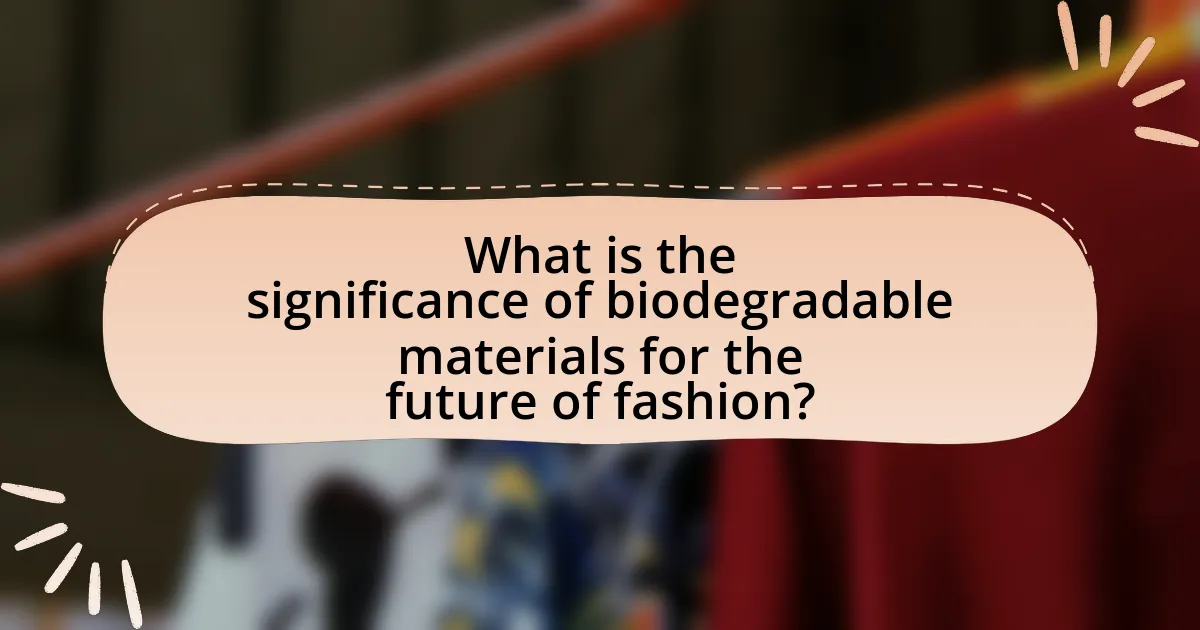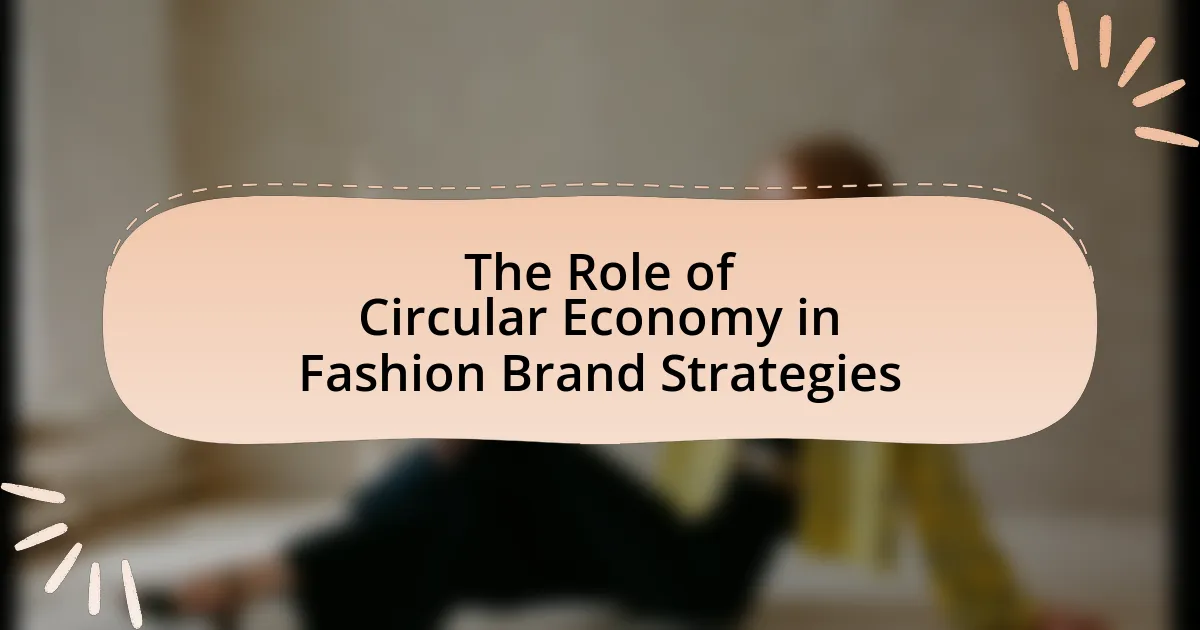The article focuses on biodegradable materials in the fashion industry, highlighting their significance in reducing environmental impact and promoting sustainability. It explains how biodegradable materials, such as organic cotton, hemp, and biodegradable polyester, differ from traditional textiles by decomposing naturally and quickly, thereby minimizing landfill waste. Key characteristics, types, and benefits of biodegradable fabrics are discussed, along with the challenges faced in their production and consumer adoption. The article emphasizes the importance of these materials for the future of fashion, advocating for a shift towards sustainable practices that align with growing consumer demand for eco-friendly products.

What are Biodegradable Materials in Fashion?
Biodegradable materials in fashion are substances that can decompose naturally through the action of living organisms, typically within a specific timeframe. These materials, such as organic cotton, hemp, and biodegradable polyester, are designed to reduce environmental impact by breaking down into non-toxic components after their useful life. For instance, organic cotton is grown without synthetic pesticides and fertilizers, making it more sustainable, while biodegradable polyester can break down in industrial composting facilities. The use of these materials is increasingly important as the fashion industry seeks to address issues related to waste and pollution, with studies indicating that textiles contribute significantly to landfill waste, highlighting the need for sustainable alternatives.
How do biodegradable materials differ from traditional materials?
Biodegradable materials differ from traditional materials primarily in their ability to decompose naturally through biological processes. Traditional materials, such as plastics and synthetic fibers, can take hundreds of years to break down, often resulting in environmental pollution. In contrast, biodegradable materials, like those derived from natural sources such as plant fibers or starch, can decompose within months to a few years when exposed to the right environmental conditions, such as moisture and microorganisms. This rapid decomposition reduces waste accumulation and minimizes the long-term impact on ecosystems, making biodegradable materials a more sustainable option in industries like fashion.
What are the key characteristics of biodegradable materials?
Biodegradable materials are substances that can be broken down by natural processes, primarily through the action of microorganisms. Key characteristics include their ability to decompose into natural elements within a short time frame, typically ranging from a few weeks to several months, depending on environmental conditions. These materials often originate from renewable resources, such as plants or animal products, which contribute to their sustainability. Additionally, biodegradable materials generally produce non-toxic byproducts during decomposition, minimizing environmental impact. For instance, studies show that polylactic acid (PLA), a common biodegradable polymer, can decompose in industrial composting facilities within 90 days, highlighting its effectiveness as a sustainable alternative to traditional plastics.
Why is biodegradability important in the fashion industry?
Biodegradability is important in the fashion industry because it significantly reduces environmental impact by ensuring that materials decompose naturally, minimizing landfill waste. The fashion industry is one of the largest polluters globally, with an estimated 92 million tons of textile waste generated annually, much of which ends up in landfills where it can take decades to decompose. Biodegradable materials, such as organic cotton or Tencel, break down within months to a few years, unlike synthetic fibers that can persist for hundreds of years. This shift towards biodegradable options helps mitigate pollution, conserves resources, and promotes sustainability, aligning with growing consumer demand for environmentally responsible practices in fashion.
What types of biodegradable materials are used in fashion?
Biodegradable materials used in fashion include organic cotton, hemp, Tencel (lyocell), and biodegradable polyester. Organic cotton is cultivated without synthetic pesticides, making it more environmentally friendly. Hemp is a fast-growing plant that requires minimal resources and is fully biodegradable. Tencel, derived from sustainably sourced wood pulp, is known for its biodegradability and low environmental impact. Biodegradable polyester, often made from renewable resources, can decompose under specific conditions, reducing landfill waste. These materials contribute to sustainable fashion by minimizing environmental harm and promoting circularity in the industry.
What are the most common biodegradable fabrics?
The most common biodegradable fabrics include cotton, linen, hemp, and Tencel. Cotton is a natural fiber that decomposes within a few months under the right conditions, while linen, made from flax plants, also breaks down quickly. Hemp is known for its durability and biodegradability, decomposing in about three months. Tencel, derived from sustainably sourced wood pulp, is biodegradable and compostable, typically breaking down within six months. These fabrics are increasingly favored in sustainable fashion due to their environmental benefits and reduced impact on landfills.
How are natural fibers utilized in biodegradable fashion?
Natural fibers are utilized in biodegradable fashion by serving as sustainable materials that decompose naturally, reducing environmental impact. These fibers, such as cotton, linen, hemp, and bamboo, are derived from plants and are preferred for their ability to break down in composting conditions, unlike synthetic fibers. For instance, cotton biodegrades within a few months, while synthetic fibers can take hundreds of years to decompose. The use of natural fibers in fashion aligns with the growing demand for eco-friendly products, as evidenced by the increasing number of brands adopting these materials to create garments that minimize waste and promote sustainability.

What is the significance of biodegradable materials for the future of fashion?
Biodegradable materials are significant for the future of fashion as they offer a sustainable alternative to traditional textiles, reducing environmental impact. The fashion industry is one of the largest polluters, with synthetic fibers contributing to microplastic pollution and landfill waste. Biodegradable materials, such as organic cotton, Tencel, and hemp, decompose naturally, minimizing waste and pollution. According to a report by the Ellen MacArthur Foundation, transitioning to biodegradable materials could significantly reduce the industry’s carbon footprint and resource consumption, promoting a circular economy. This shift not only addresses ecological concerns but also aligns with consumer demand for sustainable practices, making biodegradable materials crucial for the industry’s future.
How do biodegradable materials impact sustainability in fashion?
Biodegradable materials significantly enhance sustainability in fashion by reducing waste and minimizing environmental impact. These materials decompose naturally, unlike conventional textiles, which can take decades to break down in landfills. For instance, studies show that biodegradable fabrics, such as organic cotton and Tencel, can decompose within a few months under the right conditions, thereby decreasing the accumulation of textile waste. Furthermore, the use of biodegradable materials often involves less harmful production processes, which can lower carbon emissions and water usage compared to synthetic alternatives. This shift towards biodegradable options aligns with the growing consumer demand for eco-friendly practices in the fashion industry, promoting a circular economy where materials are reused and recycled effectively.
What role do biodegradable materials play in reducing waste?
Biodegradable materials significantly reduce waste by breaking down naturally in the environment, thereby minimizing landfill accumulation. These materials, such as organic cotton and biodegradable plastics, decompose through microbial action, which contrasts with conventional materials that can persist for hundreds of years. According to a study published in the journal “Environmental Science & Technology,” biodegradable plastics can reduce plastic waste in landfills by up to 30% when properly managed. This decomposition process not only lessens the volume of waste but also reduces harmful emissions associated with waste incineration and landfill degradation.
How can biodegradable materials contribute to a circular economy?
Biodegradable materials contribute to a circular economy by enabling the efficient recycling of resources and reducing waste. These materials break down naturally, returning nutrients to the soil and minimizing landfill accumulation. For instance, a study published in the journal “Nature Sustainability” highlights that using biodegradable textiles can significantly decrease the environmental impact of fashion waste, as they decompose within months rather than years. This process not only conserves resources but also supports sustainable agricultural practices by enriching the soil, thus closing the loop in the circular economy.
What challenges do biodegradable materials face in the fashion industry?
Biodegradable materials in the fashion industry face significant challenges, primarily related to durability, cost, and consumer perception. Durability issues arise because many biodegradable fabrics may not withstand the same wear and tear as traditional materials, leading to shorter product lifespans. Cost is another barrier, as biodegradable materials often require more expensive production processes, making them less competitive in a price-sensitive market. Additionally, consumer perception poses a challenge; many consumers are not fully aware of the benefits of biodegradable materials or may associate them with lower quality. These factors collectively hinder the widespread adoption of biodegradable materials in fashion, despite their environmental advantages.
What are the limitations of biodegradable materials in production?
Biodegradable materials face several limitations in production, including higher costs, limited availability of raw materials, and challenges in processing. The production of biodegradable materials often requires specialized equipment and processes, which can increase manufacturing expenses compared to traditional materials. Additionally, the sourcing of biodegradable raw materials, such as plant-based polymers, can be constrained by agricultural factors, leading to supply chain issues. Furthermore, the processing of these materials may not be compatible with existing manufacturing systems, necessitating investment in new technologies. These factors collectively hinder the widespread adoption of biodegradable materials in the fashion industry.
How do consumer perceptions affect the adoption of biodegradable materials?
Consumer perceptions significantly influence the adoption of biodegradable materials by shaping their willingness to choose sustainable options over conventional ones. Positive perceptions, such as beliefs in environmental benefits and health safety, drive consumers to prefer biodegradable products, leading to increased market demand. For instance, a study published in the Journal of Cleaner Production found that 70% of consumers are more likely to purchase products labeled as biodegradable, indicating a strong correlation between consumer awareness and purchasing behavior. Conversely, negative perceptions, such as doubts about performance or effectiveness compared to traditional materials, can hinder adoption. Therefore, addressing consumer concerns through education and transparent marketing can enhance the acceptance of biodegradable materials in the fashion industry.

How can the fashion industry effectively implement biodegradable materials?
The fashion industry can effectively implement biodegradable materials by prioritizing research and development of sustainable fabrics, such as organic cotton, Tencel, and biodegradable polyester. These materials decompose naturally, reducing environmental impact compared to conventional textiles. For instance, Tencel, made from sustainably sourced wood pulp, is known for its biodegradability and has been adopted by brands like Stella McCartney. Additionally, the industry can establish partnerships with innovative startups focused on biodegradable technologies, such as the company Biofabricate, which specializes in creating sustainable alternatives to traditional materials. By integrating these practices, the fashion industry can significantly reduce waste and promote a circular economy.
What strategies can brands adopt to incorporate biodegradable materials?
Brands can adopt several strategies to incorporate biodegradable materials, including sourcing sustainable raw materials, investing in research and development, and collaborating with eco-friendly suppliers. Sourcing sustainable raw materials, such as organic cotton or Tencel, ensures that the base materials are biodegradable and environmentally friendly. Investing in research and development allows brands to innovate and create new biodegradable materials that meet performance standards while reducing environmental impact. Collaborating with eco-friendly suppliers can enhance the supply chain’s sustainability, ensuring that all components of the product are biodegradable. These strategies are supported by the growing consumer demand for sustainable products, with a 2021 survey indicating that 66% of global consumers are willing to pay more for sustainable brands.
How can brands educate consumers about biodegradable fashion?
Brands can educate consumers about biodegradable fashion through targeted awareness campaigns that highlight the environmental benefits and practical applications of biodegradable materials. By utilizing social media platforms, brands can share informative content, such as videos and infographics, that explain how biodegradable fabrics decompose and reduce landfill waste. Research indicates that 92% of consumers are more likely to trust brands that provide transparent information about their sustainability practices. Additionally, hosting workshops or webinars can engage consumers directly, allowing them to learn about the lifecycle of biodegradable products and their impact on the environment. Collaborations with environmental organizations can further enhance credibility and reach, providing consumers with reliable information and fostering a community around sustainable fashion choices.
What partnerships can enhance the use of biodegradable materials?
Collaborations between fashion brands, material scientists, and environmental organizations can significantly enhance the use of biodegradable materials. Fashion brands can partner with material scientists to develop innovative biodegradable fabrics that meet consumer demands for sustainability and performance. For instance, brands like Stella McCartney have collaborated with organizations such as the Ellen MacArthur Foundation to promote circular fashion and sustainable materials. Additionally, partnerships with environmental organizations can help raise awareness and educate consumers about the benefits of biodegradable materials, thereby increasing market demand. These collaborations can lead to the development of industry standards and certifications that further validate the use of biodegradable materials in fashion, promoting wider adoption across the industry.
What are the best practices for consumers interested in biodegradable fashion?
Consumers interested in biodegradable fashion should prioritize purchasing items made from certified biodegradable materials, such as organic cotton, Tencel, or hemp. These materials decompose naturally, reducing environmental impact. Additionally, consumers should research brands that demonstrate transparency in their supply chains and production processes, ensuring that their practices align with sustainability goals. Supporting local and small-scale producers can also enhance the positive impact on the environment, as these businesses often utilize more sustainable practices. Furthermore, consumers should consider the lifecycle of their clothing, opting for items that can be composted or recycled at the end of their use, thereby minimizing waste.
How can consumers identify truly biodegradable fashion products?
Consumers can identify truly biodegradable fashion products by looking for certifications such as ASTM D6400 or EN 13432, which indicate compliance with specific biodegradability standards. These certifications ensure that the materials will break down into natural elements within a specified time frame in a composting environment. Additionally, consumers should check for transparency in the supply chain, as brands that disclose their sourcing and manufacturing processes are more likely to offer genuinely biodegradable products. Research indicates that materials like organic cotton, Tencel, and hemp are often biodegradable, while synthetic fibers like polyester are not.
What steps can consumers take to support sustainable fashion choices?
Consumers can support sustainable fashion choices by prioritizing brands that use biodegradable materials and ethical production practices. By researching and selecting clothing made from organic cotton, Tencel, or recycled fibers, consumers can reduce their environmental impact. Additionally, supporting local artisans and small businesses fosters sustainable practices and reduces carbon footprints associated with transportation. According to a 2021 report by the Ellen MacArthur Foundation, the fashion industry contributes to 10% of global carbon emissions, highlighting the importance of conscious consumer choices in mitigating climate change.




